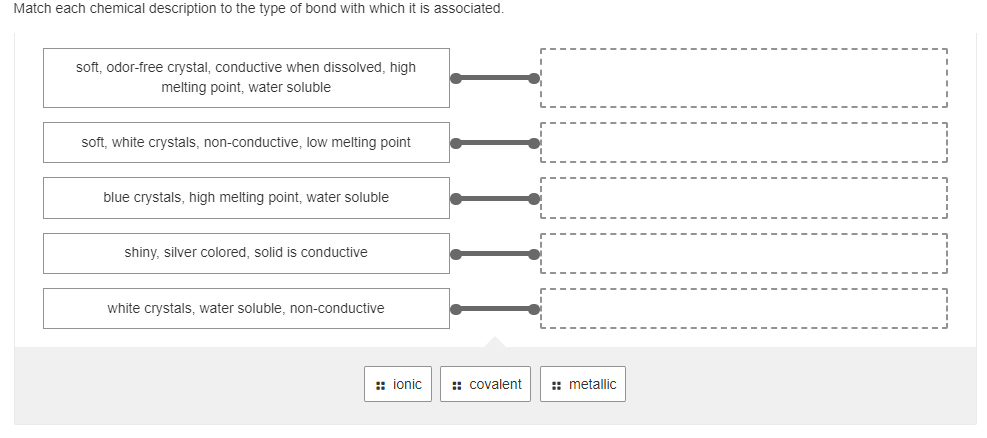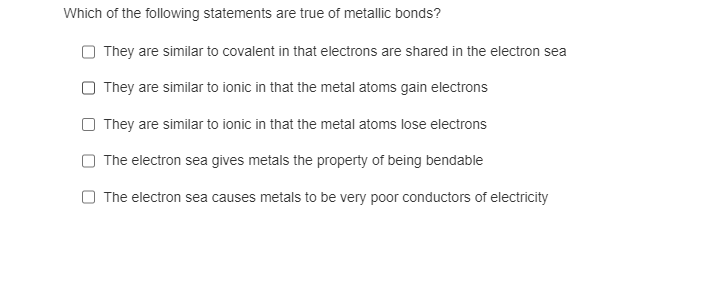Match each chemical description to the type of bond with which it is associated. soft, odor-free crystal, conductive when dissolved, high melting point, water soluble soft, white crystals, non-conductive, low melting point blue crystals, high melting point, water soluble shiny, silver colored, solid is conductive white crystals, water soluble, non-conductive ionic :: covalent :: metallic
Match each chemical description to the type of bond with which it is associated. soft, odor-free crystal, conductive when dissolved, high melting point, water soluble soft, white crystals, non-conductive, low melting point blue crystals, high melting point, water soluble shiny, silver colored, solid is conductive white crystals, water soluble, non-conductive ionic :: covalent :: metallic
Introductory Chemistry: An Active Learning Approach
6th Edition
ISBN:9781305079250
Author:Mark S. Cracolice, Ed Peters
Publisher:Mark S. Cracolice, Ed Peters
Chapter12: Chemical Bonding
Section: Chapter Questions
Problem 3CLE
Related questions
Question
1. Match each chemical description to the type of bond with which it is associated?
2. Which of the following statements are true of metallic bonds?

Transcribed Image Text:Match each chemical description to the type of bond with which it is associated.
soft, odor-free crystal, conductive when dissolved, high
melting point, water soluble
soft, white crystals, non-conductive, low melting point
blue crystals, high melting point, water soluble
shiny, silver colored, solid is conductive
white crystals, water soluble, non-conductive
ionic
:: covalent
:: metallic

Transcribed Image Text:Which of the following statements are true of metallic bonds?
They are similar to covalent in that electrons are shared in the electron sea
They are similar to ionic in that the metal atoms gain electrons
They are similar to ionic in that the metal atoms lose electrons
The electron sea gives metals the property of being bendable
The electron sea causes metals to be very poor conductors of electricity
Expert Solution
This question has been solved!
Explore an expertly crafted, step-by-step solution for a thorough understanding of key concepts.
This is a popular solution!
Trending now
This is a popular solution!
Step by step
Solved in 2 steps with 1 images

Knowledge Booster
Learn more about
Need a deep-dive on the concept behind this application? Look no further. Learn more about this topic, chemistry and related others by exploring similar questions and additional content below.Recommended textbooks for you

Introductory Chemistry: An Active Learning Approa…
Chemistry
ISBN:
9781305079250
Author:
Mark S. Cracolice, Ed Peters
Publisher:
Cengage Learning


Chemistry: Matter and Change
Chemistry
ISBN:
9780078746376
Author:
Dinah Zike, Laurel Dingrando, Nicholas Hainen, Cheryl Wistrom
Publisher:
Glencoe/McGraw-Hill School Pub Co

Introductory Chemistry: An Active Learning Approa…
Chemistry
ISBN:
9781305079250
Author:
Mark S. Cracolice, Ed Peters
Publisher:
Cengage Learning


Chemistry: Matter and Change
Chemistry
ISBN:
9780078746376
Author:
Dinah Zike, Laurel Dingrando, Nicholas Hainen, Cheryl Wistrom
Publisher:
Glencoe/McGraw-Hill School Pub Co